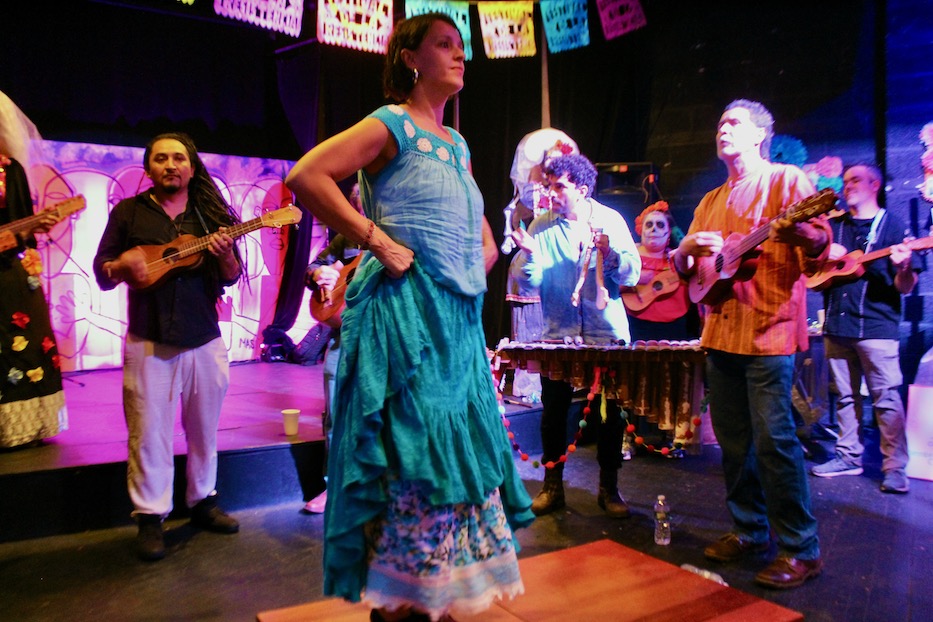
Bregamos Community Theater | Culture & Community | Dia de los Muertos | Fair Haven | Arts & Culture | Arts & Anti-racism | Semilla Collective
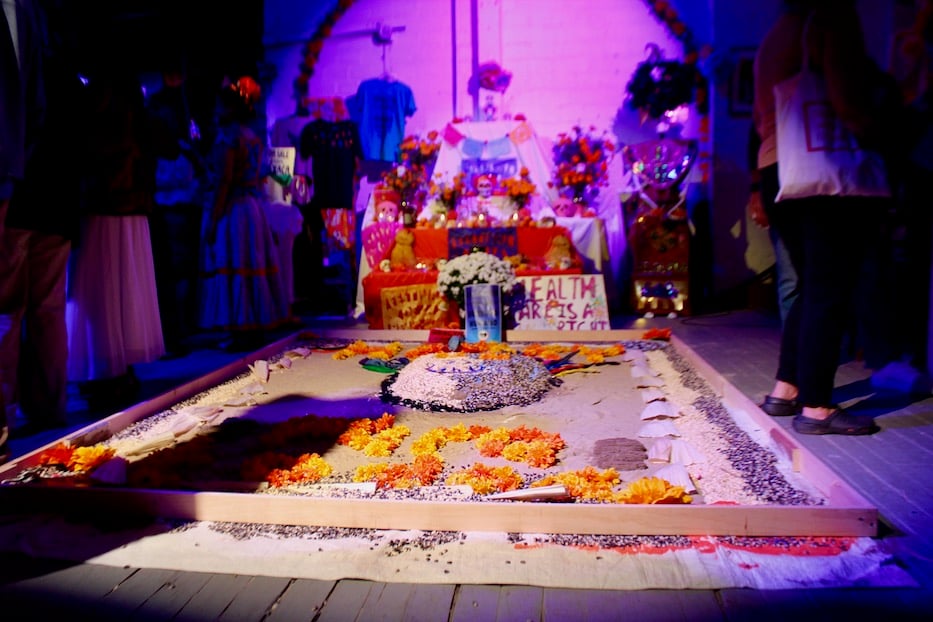
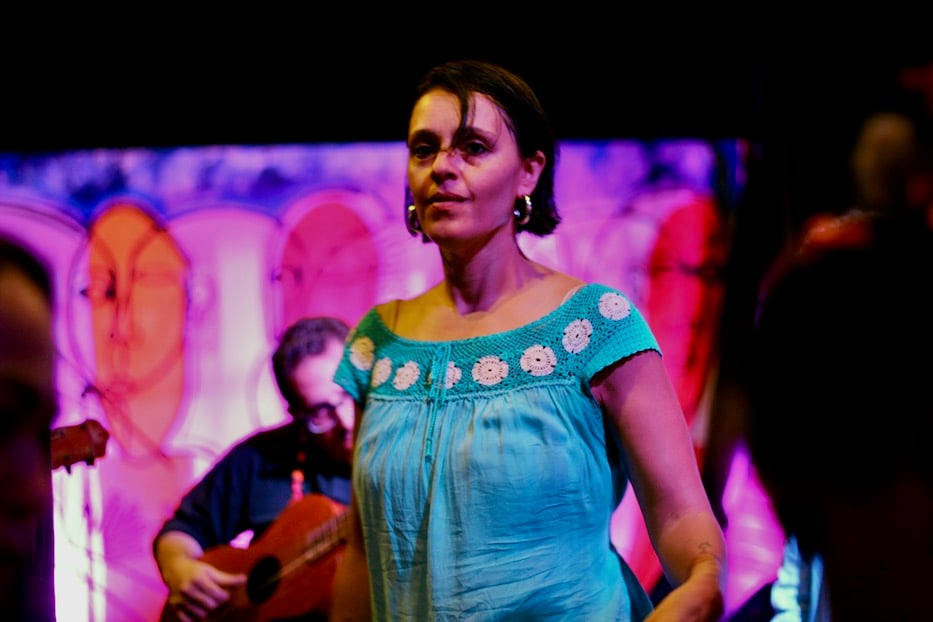
Top: The community ofrenda, or memorial altar. Bottom: Julia del Palicio. Lucy Gellman Photos.
The sound of footfalls, requinto and jarana echoed through Bregamos Community Theatre, making its way up to the rafters, over the lip of the stage, back through the double doors and down a ramp outside. It fluttered through bright paper flags and swooped to the ground, where some of the smallest dancers took tiny steps back and forth.
Laughter, dancing, and hours of son jarocho set the scene for the Semilla Collective’s second annual “Festival de la Resistencia” (Festival of Resistance) last Saturday night, held at Bregamos Community Theater in Fair Haven. After weeks of preparation, the night became a celebration of both Día de los Muertos and the work Semilla has done for worker and immigrant rights in the past year.
“This is very special for me,” said Denise Cruz, who is originally from Oaxaca, and spent weeks decorating the delicate papel picado banners that fluttered overhead. “My heart is with the community.”
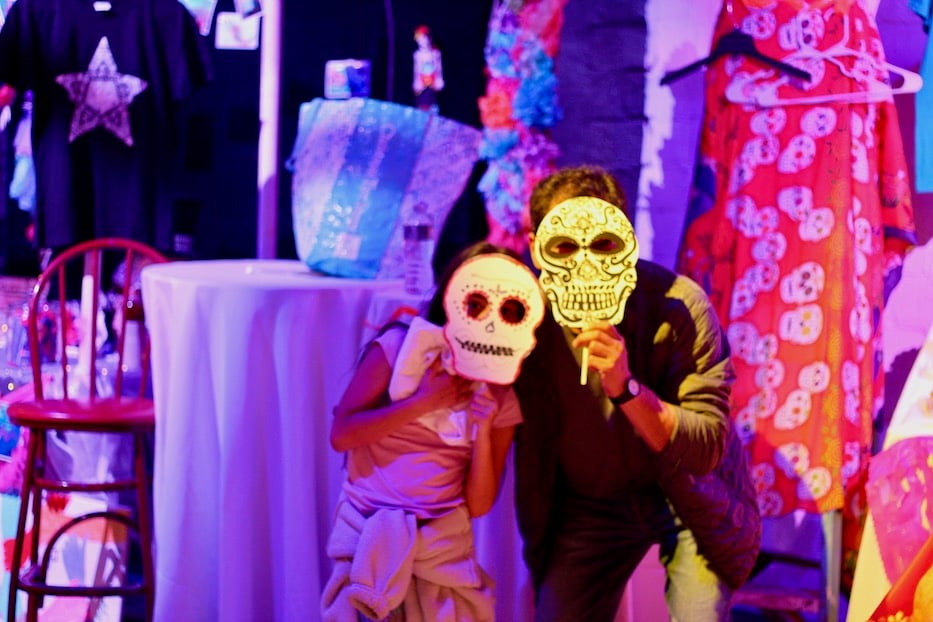
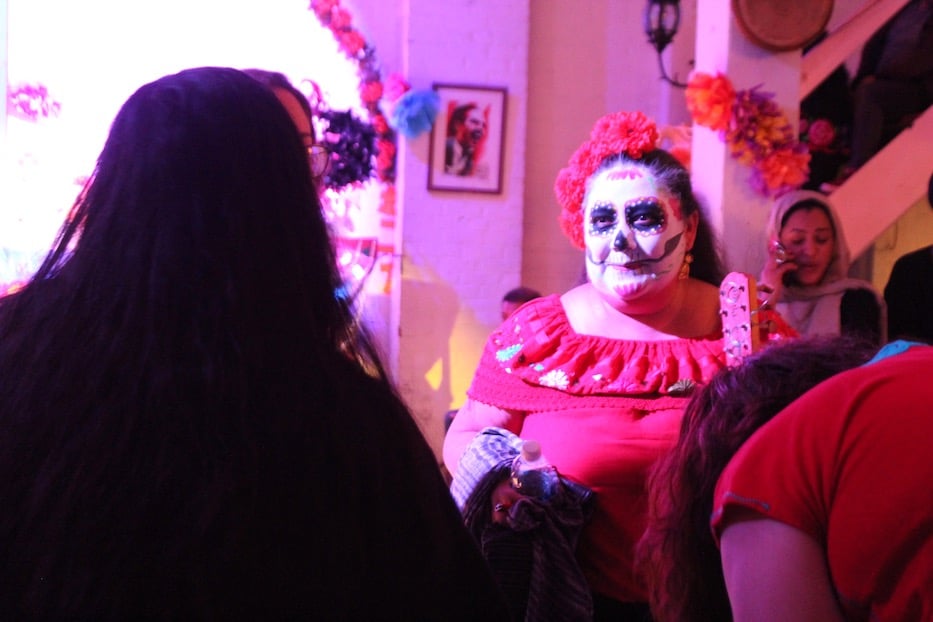
Top: Lucia and Carlos Ibanez. This year, Ibanez said he is remembering his grandfathers, uncles and aunts as he passes the Día de los Muertos tradition on to his 10-year-old daughter. Bottom: Fatima Rojas. Her husband led a bicycle tour earlier in the afternoon. Lucy Gellman Photos.
For weeks, Semilla has been preparing for the festival, holding nightly artmaking sessions and music practices in members’ homes and at Havenly’s downtown storefront. This year, members of the collective chose to honor victims of a broken healthcare system—those who died waiting for, or received incomplete, medical care. It is part of their fight for Husky 4 immigrants, which would expand Connecticut’s Medicaid program to all immigrants, regardless of documentation status.
As Saturday neared, many hands made light work, said member Camila Güiza-Chavez. Cruz’ papel picado flags joined large skeletons, huge crepe paper flowers, and garlands of fresh marigolds that glowed a warm welcome as they found their place in the low-lit theater. Saturday morning, Cruz went to the beach to collect sand for a tapete de arena, or a rug of sand designed to commemorate the dead.
Behind it, Semilla members created a community ofrenda, or memorial altar, stacked with painted skulls, flickering candles, vases of mums and marigolds, and small, rounded loaves of pan de muerto sprinkled with seeds. Photos of family members and friends peeked out from the altar’s raised rows, each carrying a different story of a system that had failed them. The stage was set to pay homage—and for hours, attendees did.
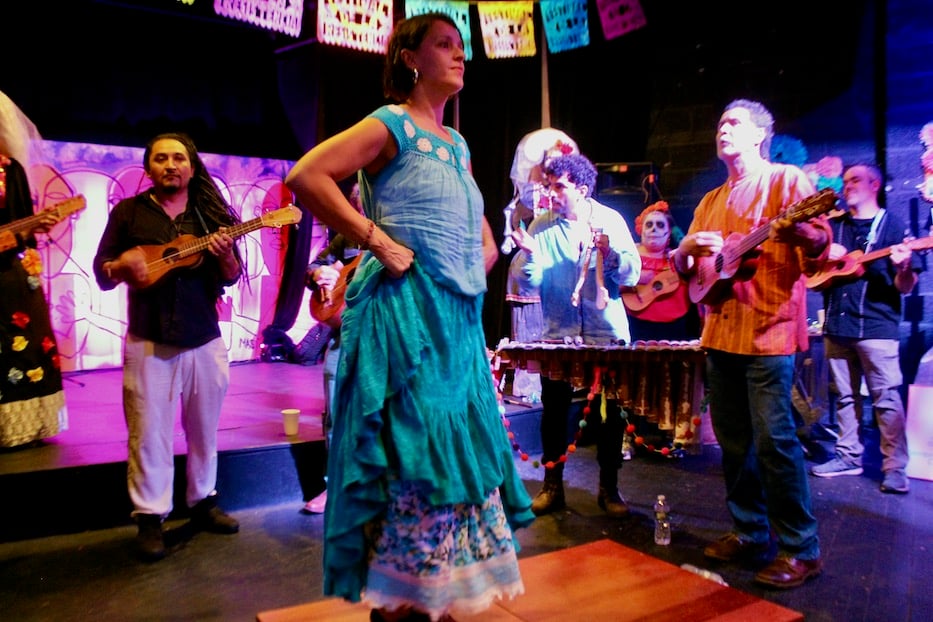
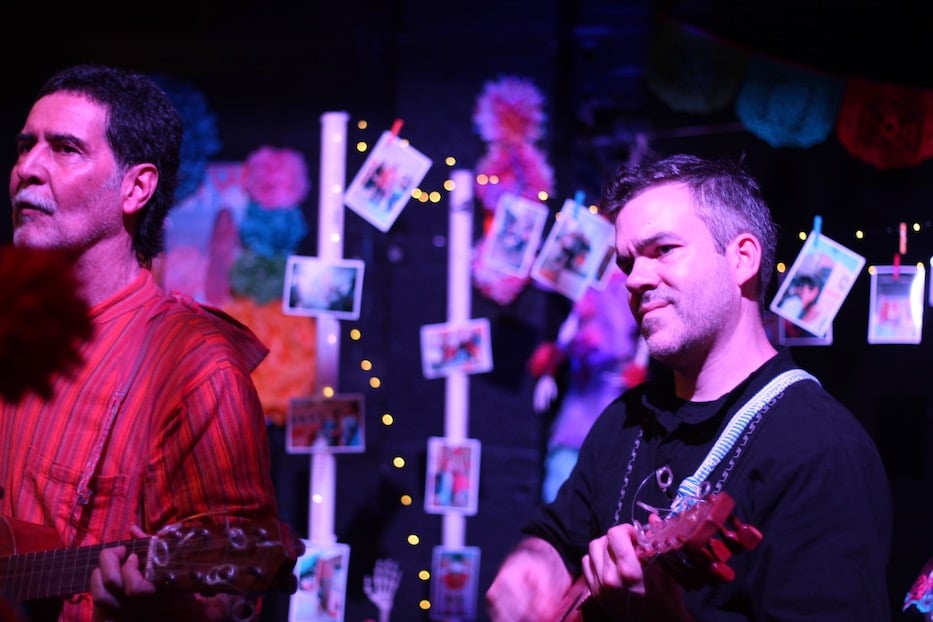
Son jarocho filled the theater for over an hour. Top: Julia del Palicio gets the fandango going. Bottom: Fernando Guadarrama and Joseph Foran. Lucy Gellman Photos.
As dusk fell outside, music and dancing filled the theater, the sound often weaving in and out of conversation. Outside, half a dozen young kids kicked around a soccer ball, their high-pitched, giggle-flecked Spanish and English floating through the air. Inside, the smell of food drifted across the space, from fresh, still-warm corn tortillas to Guatemalan pupusas, tlacoyos stuffed with beans and topped with crumbly cotija cheese, and special cheese, pork, and blueberry tamales prepared with the festival in mind.
Wrapped in the sound of son jarocho, Alegría Café’s Maria Torres doled out tlacoyos and sweet and savory tamales, drizzling the first with homemade salsa verde before handing over the heavy, still-warm plates. This year, she said, she was grateful for a communal space to observe Día de los Muertos, which she faithfully does at home each year. On the ofrenda she shares with her husband and children at home, she prepares tamales, mole poblano with turkey, and bottles of pulque and tequila.
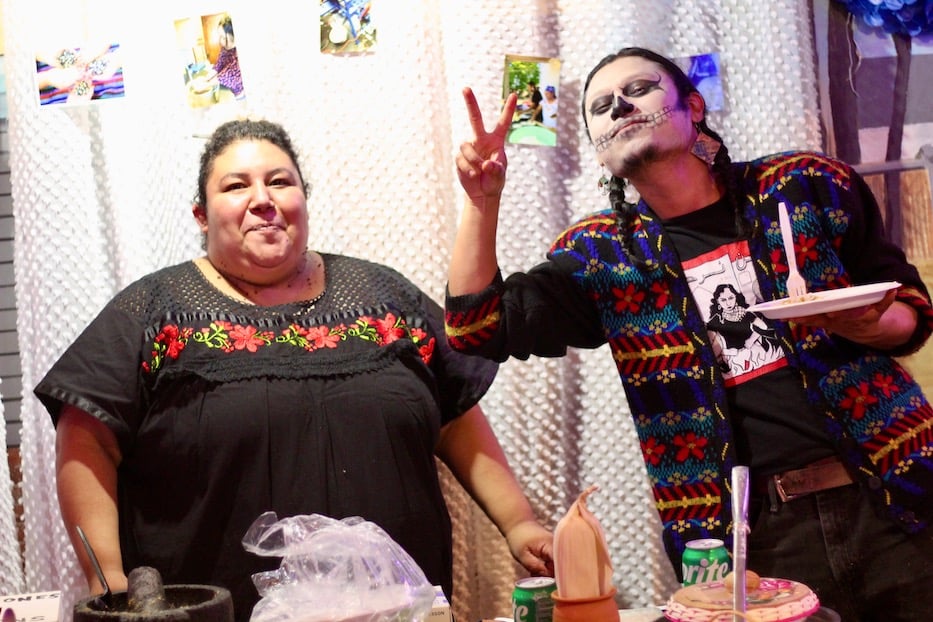
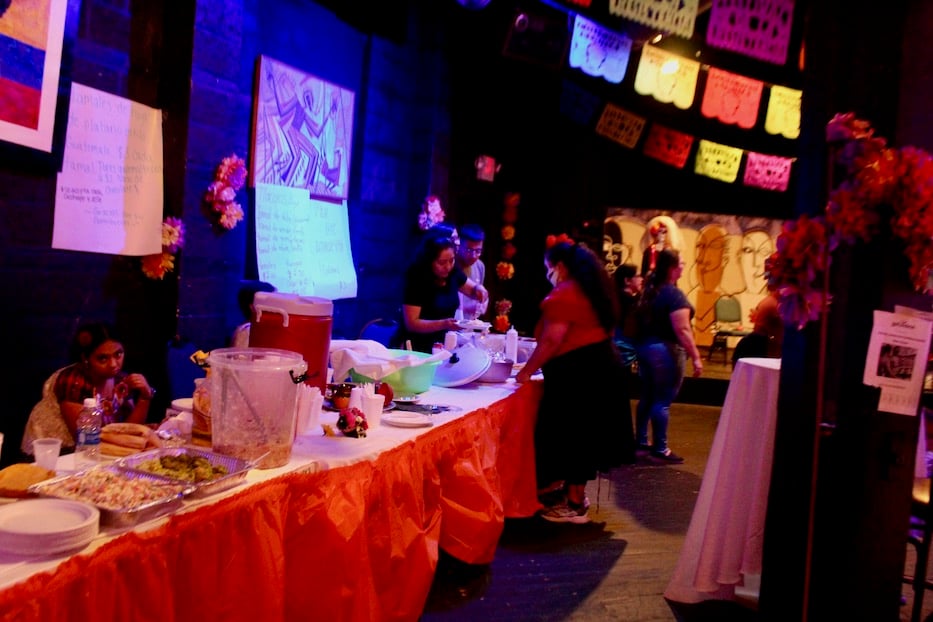
Top: Elizabeth Gonzalez and Javier Villatoro (a.k.a. Ene de Nadie). Bottom: The festivities. Lucy Gellman Photos.
Across the room, Tortilleria Semilla’s Elizabeth Gonzalez said she was happy to be sharing her food—and her story—at the event. Born and raised in Tlaxcala, Mexico, Gonzalez came to New Haven two decades ago, and has since made a life in the city. She credited her father Jesus, “who showed me how to work really hard,” with a work ethic and sharp focus that she still holds onto today. “He showed me the way,” she said.
Every year, she honors his and other family members’ memory with an ofrenda covered with candied pumpkin and sweet potato, mole with chicken, coffee, pulque, chocolate and the traditional pan de muerto. As she spoke, her hands sailed absentmindedly over a tablecloth, glass jar of corn and donation box.
It is their legacy that allows her to be in New Haven, she added. For over a year, the tortilleria has looked at food as a pathway to economic empowerment. Collective members make tortillas through the traditional Aztec and Maya tradition of nixtamalization, meaning that the tortillas are more nutrient-rich and the dough is typically easier to work with. Gonzalez called it a way to both build community and honor a tradition that is thousands of years old.
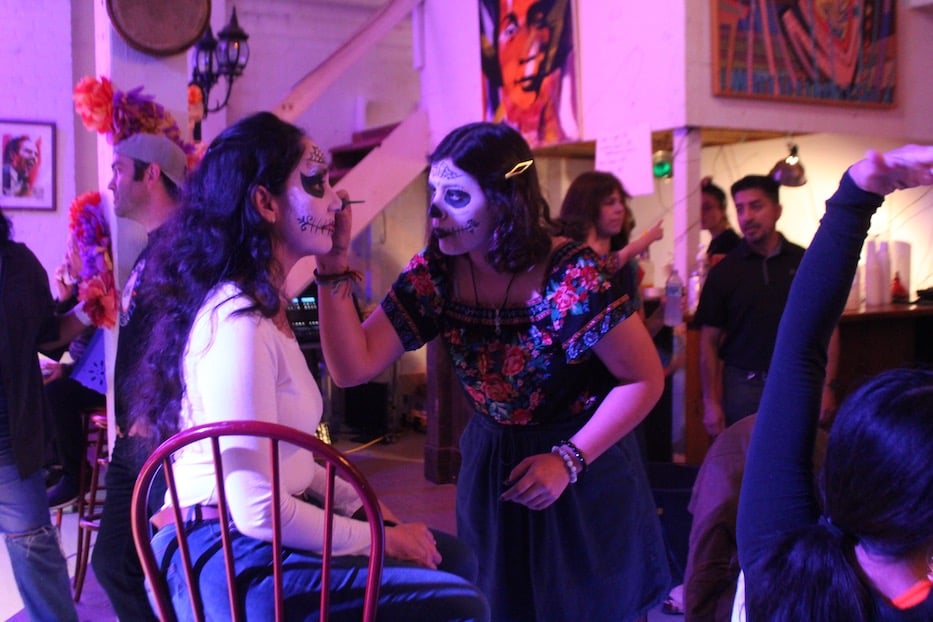
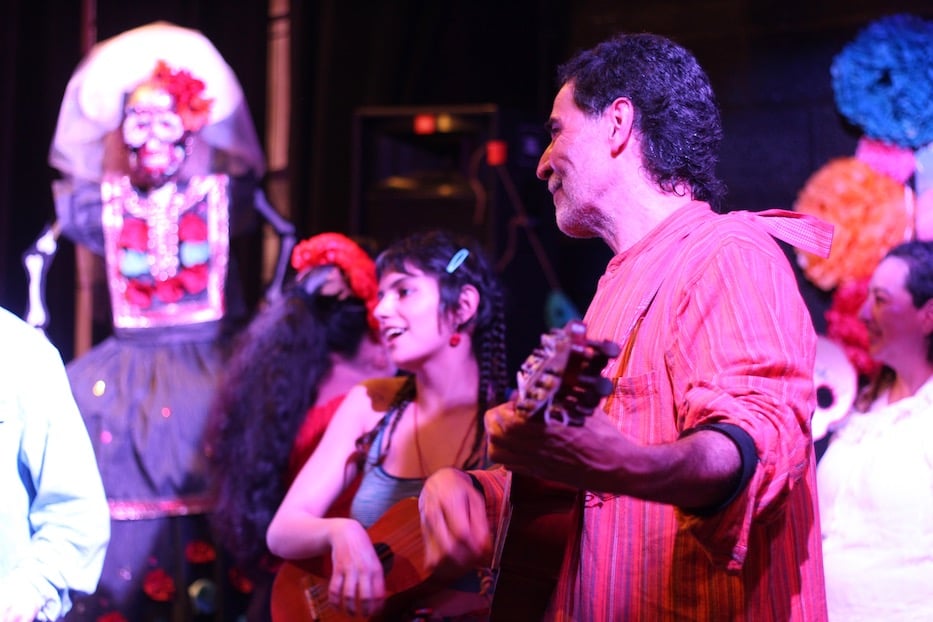
Top: Micaela Arenas on duty. Bottom: Fernando Guadarrama. Lucy Gellman Photos.
Back by the stage, the sound of son jarocho filled the air, bridging the gap between New Haven and Veracruz as musicians picked up instruments and played, often dancing as they strummed and sang. At the center of the group, zapateado dancer Julia del Palicio laid down a wooden platform or tarima, her feet filling in part of the percussion section as she moved. Beneath her, the sound of marimba swelled, its notes round and full as they bounced from the instrument to the high ceiling.
As the room began to sing along to “La Bamba,” two generations of dancers joined her, from four- and five-year-old attendees in cotton dresses and all manner of legging to their mothers in bright embroidered blouses and flower crowns. Musician Fernando Guadarrama, who had come from Oaxaca for the event, later said that the fandango, a communal dance that is part of the son jarocho tradition, made him feel like he was back in Mexico.
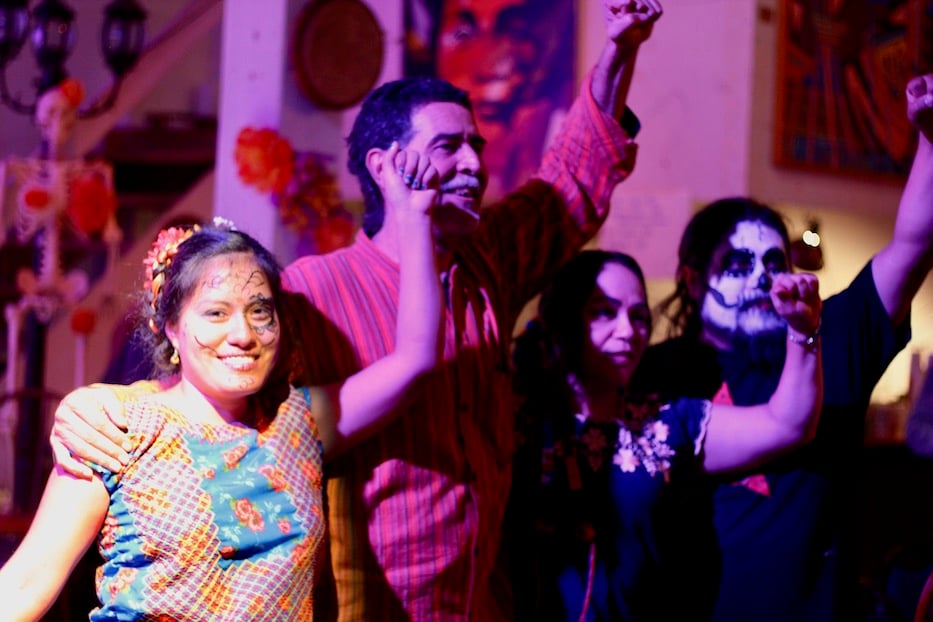
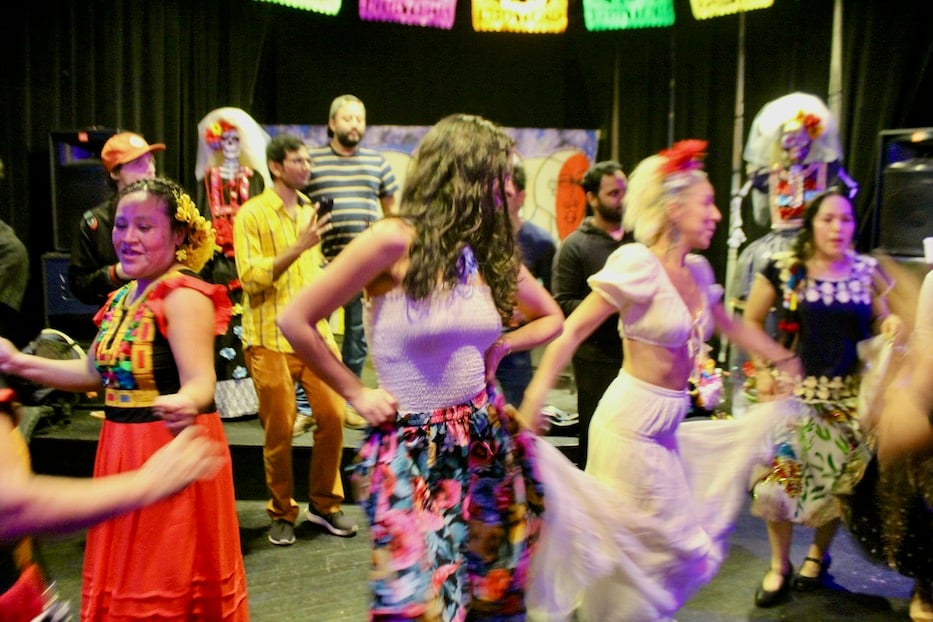
Top: Denise Cruz, Fernando Guadarrama, Ana Hernandez, and Perick Appo. Bottom: Attendees danced late into the night. Pictured at center isCamila Güiza-Chavez. Lucy Gellman Photos.
As they celebrated, many attendees also paused to remember those who were no longer there among the living. Examining a large bin of homemade, cinnamon-spiced pan de muerto, Semilla’s Fatima Rojas said the festival took her back to a childhood in Puebla, Mexico, where her grandmother would spend hours preparing beets with vanilla and cinnamon.
Placing them in a clay pot called a cazuela, she would mash them for hours, inviting every family member to join in. After seven or eight hours of mashing, family members would spread the mixture over their pan du muerto.
This year, she is remembering her grandmother, who died in Mexico last year. At home, she and her family have an ofrenda each year, paying tribute to those who have come before them.
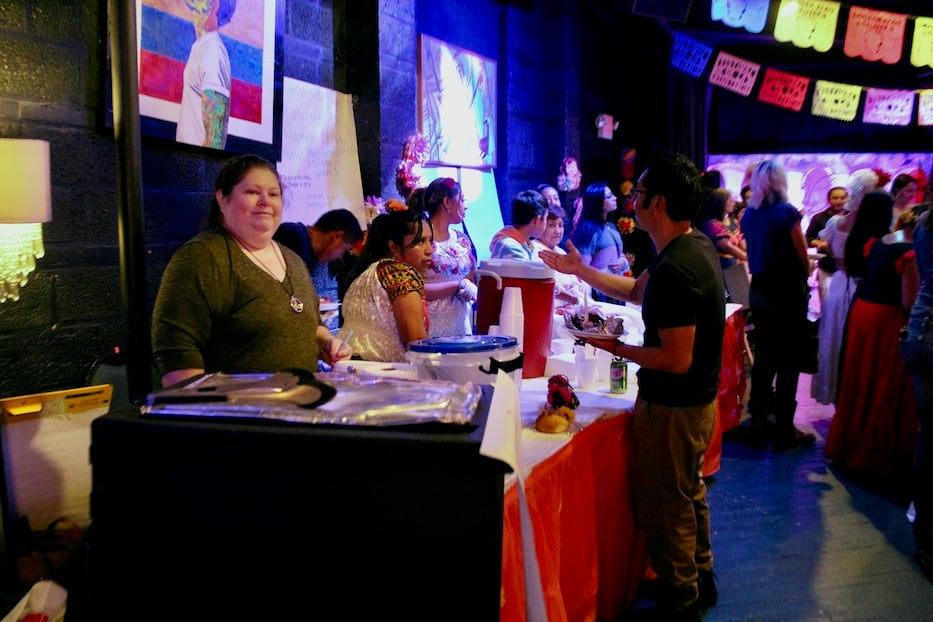
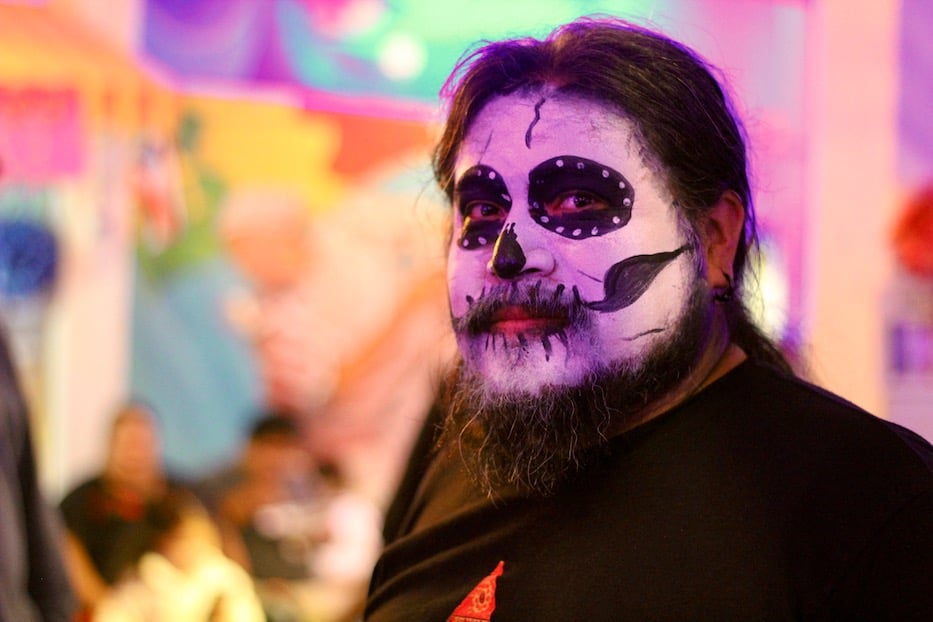
Top: Sandra Trigueros served up pupusas until she was out. Bottom: Perick Appo. “Think of all those people that left [us]. They’re in front of us now," he said. Lucy Gellman Photos.
As they looked over the community ofrenda, Javier Villatoro (a.k.a. Ene de Nadie) remembered growing up in Oaxaca, where it was customary to remember children who had passed before adults. A member of the Zapotec nation, Villatoro left Oaxaca with their family when they were 18, fleeing poverty and anti-Indigenous violence.
Saturday, they graced the stage with original music, paying homage in poetry and song. Minutes before performing, they said that they are remembering an aunt who passed away of a heart condition. They looked out onto the communal altar as they spoke, their eyes tracing miniature cobs of corn and a flower-studded skull that Cruz had sculpted out of sand.
“We celebrate their lives,” Villatoro said of the dead. “They are coming back to us.”
Nearby, Perick Appo said that he was remembering his grandmother, aunt, uncle, and friend Beto, who died at 20 years old in a car accident—as well as the tens of thousands of people who have died because of Covid-19. At 19, he left Oaxaca for the U.S., ultimately settling in New Haven. Each year, he carves out time to remember those who have crossed over into the spirit world, welcoming them back at the beginning of November.
“We do this to not forget people,” he said. “Think of all those people that left [us]. They’re in front of us now.”
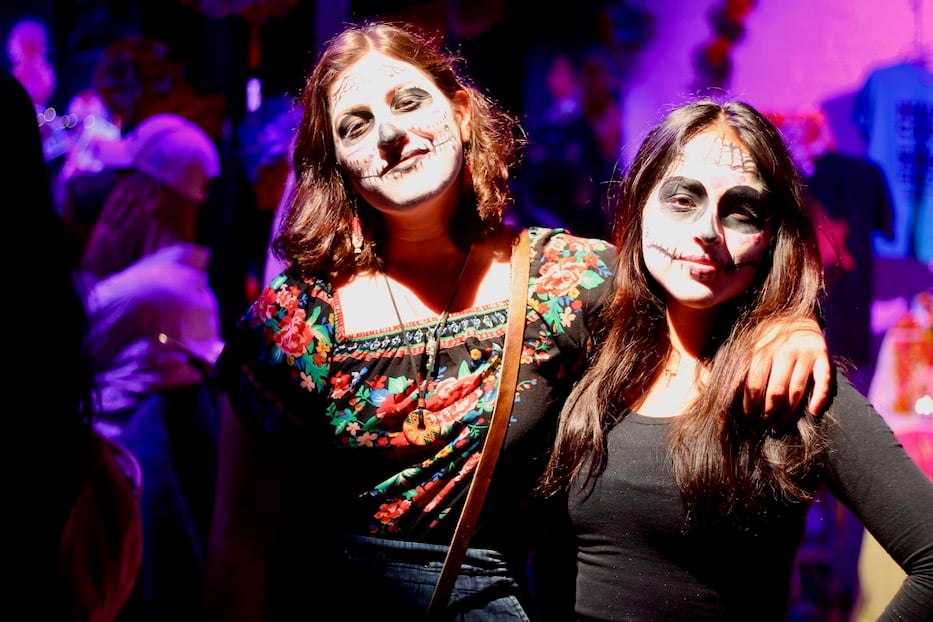
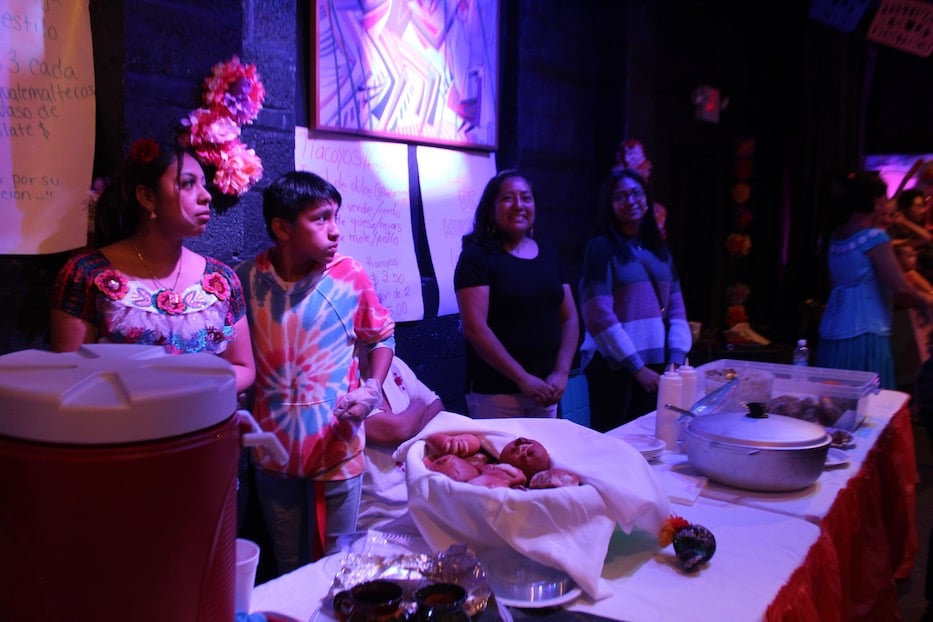
Top: Micaela Arenas and Nicole Cristobal. Bottom: Attendees watch as dancing and music sweep the floor. Alegria Café's Maria Torres is pictured in the black shirt, smiling. Lucy Gellman Photos.
Closer to the ofrenda, friends Micaela Arenas and Nicole Cristobal studied the sand carpet, where a mound of pebbles rose up to meet a sand skull with bright crepe paper hair. Raised in Manchester to parents who are Bolivian and Argentine, Arenas said that she was grateful for the space, which felt both welcoming and safe. She had spent most of the evening transforming attendees into catrinas, and now walked around the theater with Cristobal, taking everything in. Every so often, they exchanged an unspoken glance, and giggled.
“I feel like it’s a good way for people to come together,” she said, pointing to the dozens of immigrant families who filled the space with their laughter, conversation and customs. As a high school student, she said, the threat of violence is never far from her mind—her school had held a two-hour lockdown the week before. “It’s a nice kind of environment being here. It feels safe.”
Close to the stage, son jarocho had given way to poetry, the words wrapping attendees as they drifted past tables. Half-listening even as she answered questions, Ana Hernandez pointed to the night as not just a celebration of the dead—and the living who loved them—but also of Semilla’s championing of worker rights in the past year, as its mutual aid and activist footprint has grown.
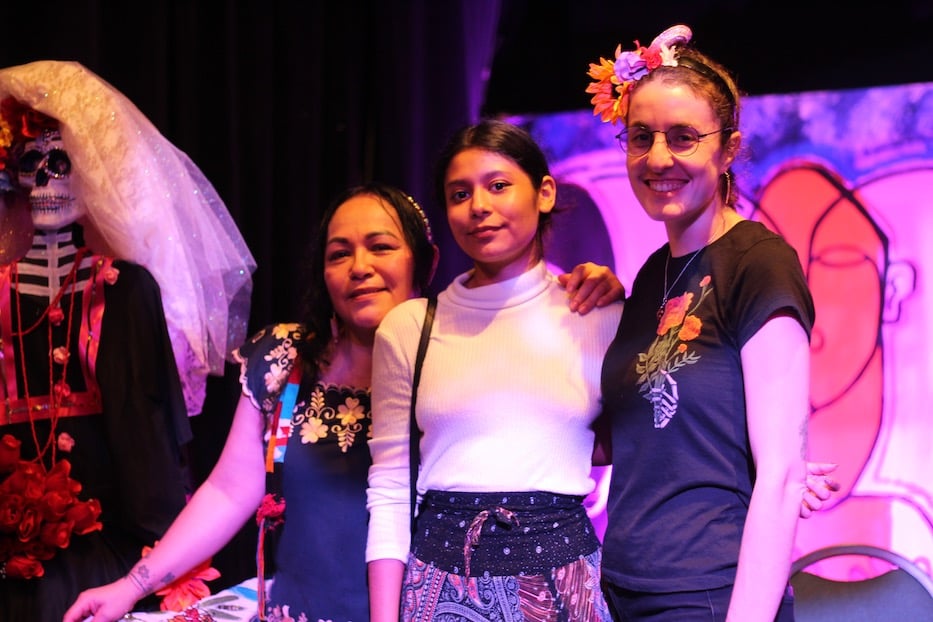
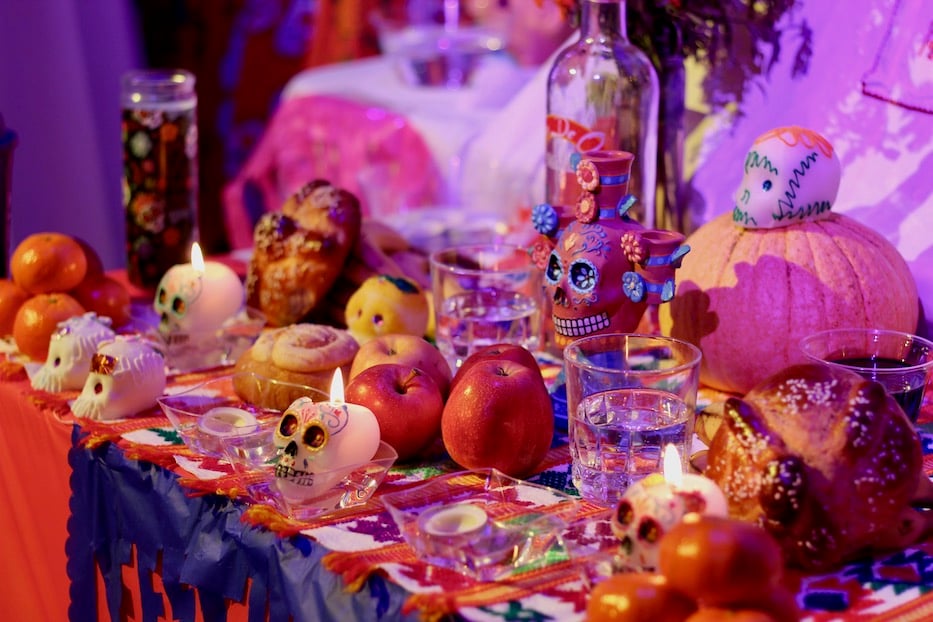
Top: Ana Hernandez, Ariana Shapiro, and Lluvia Gonzalez. Bottom: A detail of the community ofrenda. Lucy Gellman Photos.
Over a year ago, she became a member of the collective when members were fighting a labor case that they later won. As one of the workers who felt exploited (she asked not to mention the employer), she was grateful to have members of Semilla behind her, she said. Saturday, she was glad to be celebrating that win—and building up a reserve of energy for the next fight.
Outside, Guadarrama stood watching a game of pickup soccer that had lasted close to three hours, with a rotating cast of pint-sized players. Born and raised in Veracruz, he ended up at the festival by way of Oaxaca, where he met Cruz and Appo during a 2006 teachers’ strike in the city. In July, he saw them for the first time in 16 years at “Fandango at the Wall,” a music festival held in Brooklyn Bridge Park. Appo urged him to come to New Haven to perform.
“I think it’s so important to have a community of people, of immigrants,” he said, later adding that this is the season he remembers grandparents, parents and siblings who have passed on. “Here, it’s a traditional party, it’s bringing together all these immigrants from Mexico. It’s beautiful.”
Learn more about the Semilla Collective here. For more from the event, check out the Arts Council's videos on Facebook live.

